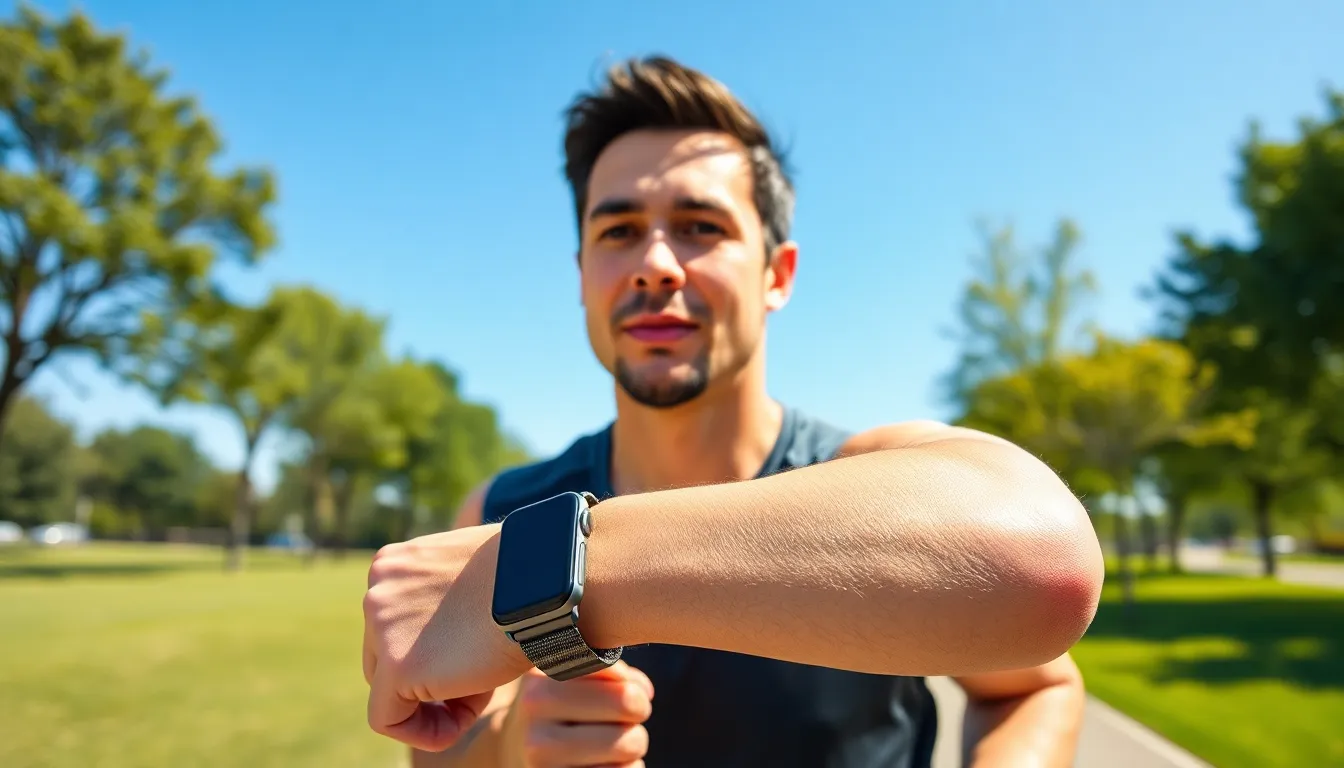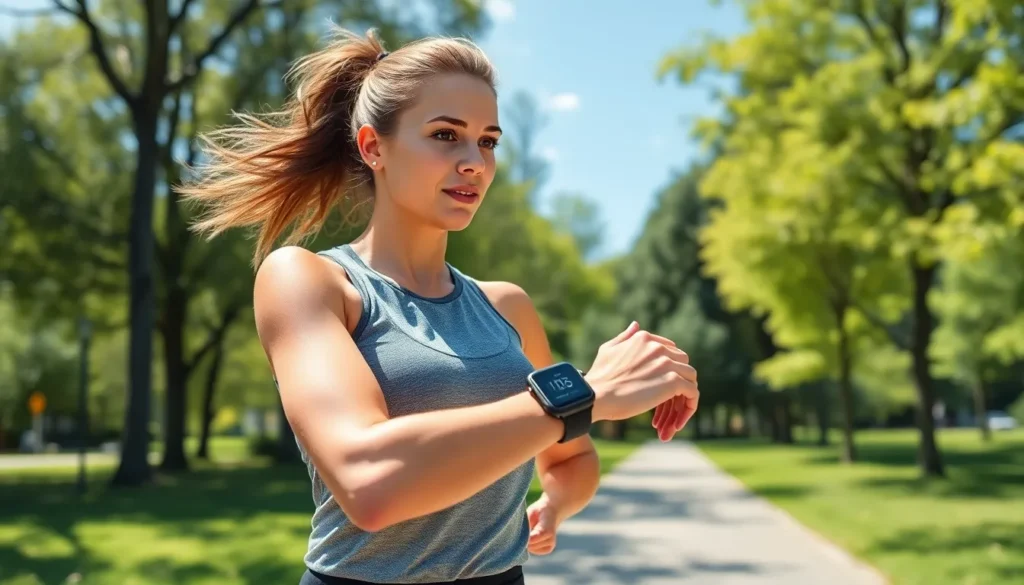Table of Contents
ToggleIn a world where even your refrigerator can remind you to eat your greens, it’s no surprise that tech has invaded the fitness realm. Gone are the days of counting calories on paper or guessing how many steps you’ve taken. Today’s gadgets do all the heavy lifting—literally! From smartwatches that track your heart rate to apps that turn workouts into games, technology is here to make fitness not just effective but downright fun.
Overview of Tech for Fitness
Technology profoundly influences the fitness industry. Advanced gadgets replace manual methods like calorie counting and step estimation. Smartwatches monitor heart rates, track workouts, and provide real-time feedback, enhancing performance. Fitness apps offer personalized workout plans, nutrition tracking, and community support, fostering motivation.
Wearable devices, such as fitness trackers, play a crucial role in daily activity monitoring. They help individuals set realistic goals based on historical data and performance metrics. Virtual reality workouts create immersive experiences, engaging users in ways traditional exercises cannot.
Health data collected from devices aids in understanding individual fitness levels and preferences. This data-driven approach promotes informed decisions about training routines and nutritional choices. AI algorithms analyze trends and provide tailored recommendations that align with users’ fitness journeys.
Social media platforms contribute to the fitness landscape as well. Users share their progress and seek accountability from non-personal networks, further enhancing motivation. Online classes and fitness challenges connect enthusiasts globally, breaking geographical barriers.
The integration of tech in fitness also equips professionals with tools to analyze client performance. Personal trainers leverage advanced analytics to optimize individual training sessions. This evidence-based approach elevates personal training beyond traditional methods, ensuring effective client progress.
Emerging technologies, like genetic testing and nutrition analytics, revolutionize personalized fitness plans even further. They provide insights that consider unique genetic makeups, adjusting strategies for improved results. With continuous innovation, tech for fitness evolves, offering diverse solutions for every fitness enthusiast.
Wearable Fitness Technology

Wearable fitness technology significantly enhances personal health and workout efficiency. These devices track and analyze user activities to provide insights that motivate and improve performance.
Smartwatches and Fitness Trackers
Smartwatches and fitness trackers dominate the wearable tech market. These devices monitor daily steps, calories burned, and distance traveled. Many models feature heart rate tracking, sleep analysis, and GPS capabilities. Users can set personal fitness goals and receive feedback in real-time. Seamlessly, they integrate with smartphones, allowing users to receive notifications and manage apps easily. Popular brands like Apple, Fitbit, and Garmin offer various models suitable for different lifestyles and preferences. Reading reviews and comparing features assists users in selecting the ideal device tailored to their needs.
Heart Rate Monitors
Heart rate monitors play a crucial role in fitness training. These devices offer accurate heart rate readings during workouts, ensuring users exercise within their target heart rate zones. Variants include chest straps and wrist-based monitors, each providing unique benefits. Chest straps typically deliver more precise measurements, while wrist-based options offer greater convenience. Many heart rate monitors sync with fitness apps, allowing users to track progress over time. Analyzing heart rate data helps individuals understand their cardiovascular fitness levels and adjust their training routines accordingly. Regular monitoring can enhance overall workout effectiveness and support specific fitness goals.
Fitness Apps and Software
Fitness apps and software play a crucial role in enhancing workout routines and nutrition management. They empower users to track progress, set goals, and maintain healthy lifestyles with ease.
Workout Tracking Apps
Workout tracking apps streamline the process of monitoring fitness activities. Users log exercises, record reps, and track personal bests, allowing for data-driven improvements. Popular options include MyFitnessPal and Strava, which offer features for tracking runs and other workouts. Many apps provide visual progress reports, motivating users to reach new milestones. Integration with wearable devices elevates functionality, assisting in real-time feedback during workouts. Users benefit from exercise demos and community forums that encourage engagement and accountability.
Nutrition and Meal Planning Apps
Nutrition and meal planning apps simplify healthy eating. MyPlate and Lose It! serve as tools for users to track caloric intake and macronutrient ratios. Custom meal plans cater to individual dietary preferences and restrictions, ensuring a balanced approach to nutrition. Interactive grocery lists make shopping efficient, while recipe suggestions introduce variety. Users can connect with nutritionists through some apps, adding professional insight. Tracking hydration and meal timings fosters better eating habits, aligning with fitness goals.
Home Gym Equipment
Home gym equipment integrates technology into workout routines, enhancing performance and convenience for users.
Smart Weights and Resistance Machines
Smart weights offer automatic adjustments based on user inputs and physical goals. These devices track performance metrics like reps, sets, and weight lifted, providing real-time feedback on progress. Resistance machines also include smart features that adapt resistance in response to user strength levels. Individuals can experience personalized workout plans, tailored to their preferences and fitness levels. Examples include the Tonal and JAXJOX smart weights, which allow for versatile exercises and create an efficient training experience at home.
Interactive Fitness Platforms
Interactive fitness platforms revolutionize the home workout experience. Users engage with virtual sessions led by trainers in real-time, participating in various classes from yoga to strength training. Platforms such as Peloton and Mirror utilize advanced technology to monitor user performance and provide immediate feedback. Social features enable users to connect with friends, fostering community through shared fitness goals. These platforms further motivate individuals by tracking progress and offering leaderboard rankings, creating a competitive yet supportive environment.
The Future of Tech for Fitness
Emerging technologies continue to shape the future of fitness. Expect wearable devices to evolve, integrating advanced metrics for tracking health and performance. Enhanced sensors will monitor more than just heart rates; they may soon analyze hydration levels, stress responses, and even recovery metrics.
Artificial intelligence plays a pivotal role in personalization. Algorithms will predict user preferences and suggest workouts tailored to individual goals, creating a customized fitness journey. Integration with healthcare providers may become more common, allowing users to share vital health data securely.
Virtual reality workouts stand to revolutionize home exercise. Participants may engage in immersive environments that mimic real-world locations, enhancing motivation and enjoyment. Remote personal training could grow as trainers utilize augmented reality to lead sessions and provide instant feedback on form and technique.
Nutrition technology will also advance. Smart kitchen devices may track ingredient inputs and suggest meal plans based on user fitness levels and dietary restrictions. Apps will offer seamless integration between workout tracking and nutritional guidelines, creating holistic health plans.
Social engagement through tech is likely to expand. Fitness communities on platforms will thrive, connecting individuals with similar goals and interests. Shared challenges will promote accountability, making fitness a more collective experience.
Lastly, smart equipment will continue to evolve. Home gyms might include machines that adapt workouts based on user performance, providing a personalized and challenging environment. Enhanced connectivity features could allow for real-time competitions and collaborative training with friends or family, encouraging consistent engagement.
The intersection of technology and fitness is undeniably transforming how individuals approach their health and wellness. With the rise of wearable devices and advanced fitness apps, achieving personal goals has never been more accessible. These innovations not only enhance workout experiences but also foster a sense of community among fitness enthusiasts.
As technology continues to advance, the potential for personalized fitness solutions will only grow. Future developments promise to bring even more tailored experiences that cater to individual needs. Embracing these tools can lead to more effective workouts and healthier lifestyles. Staying informed about these advancements will empower users to make the most of their fitness journeys.







